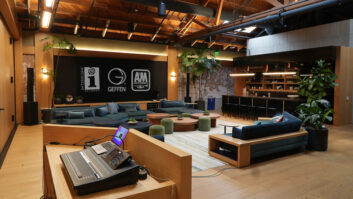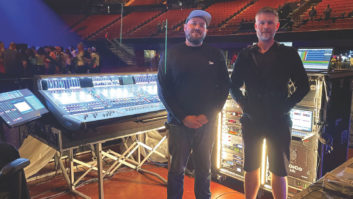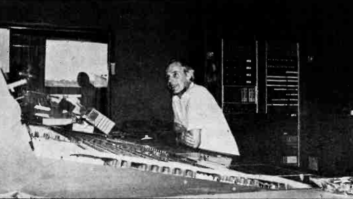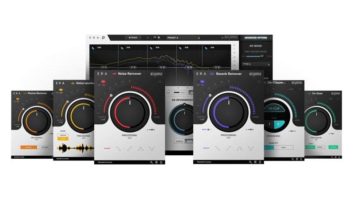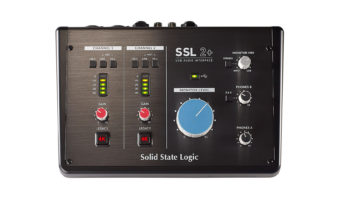I’ve made it a tradition to go easy in the AES issue and tone downthe geek speak for more tangible concepts. It’s always a good idea tozoom out once in a while, so whether you’re fried from “theshow” or just unable to focus on minutiae, this month, we’llexplore “listening space clutter” and other audio obstaclesin our organic quest for higher-resolution audio.
No matter where you are in the audio food chain, high-resolutionaudio has become the affordable rule rather than the expensiveexception. To consume mass quantities of bits or not, that is thequestion, as well as your option. That no 24-bit converter actuallydelivers 24 bits of resolution is not an issue of quality but ratherone of theoretical limitations. It applies to electronics and acousticspaces, although we tend toward thinking that gear can solve all of ourproblems.
For example, Prism is but one company that makes premium converters.Check out www.prismsound.com, and you’ll find an incrediblearray of impressive performance specs, but even they can“only” deliver about 21.5 bits of resolution. To deliverthe extra 2.5 bits, the unit would have to be chilled to an icy-273.15° Centigrade, otherwise known as 0° Kelvin or AbsoluteZero. That’s as geek as this column will get.
No matter how many bits you choose, playing the numbers game is allfor naught if the listening space is not up to the task. There areenough sonic obstacles in the typical control room to interfere withyour pleasure of actually hearing the resolution we’ve paid for, even16 bits’ worth! Some of the fixes may be obvious and relatively easy.So, let’s shift the focus from gear to space and see what happens.
FORK-U
At each step along the path — from basic tracks to mastering— you’ll find a fork in the road, one that can make your lifeeasier or miserable. For music recording, the rhythm tracks should fittogether just by throwing up the faders. Reaching for EQ as the firstfix is a detour on a bumpy road. Fixing the problem at the source willhave a positive ripple effect.
Did you know, for example, that the position at which a cardioid micdelivers flat response is typically 1 meter (3.3 feet)? As the mic ismoved closer to the sound source, the inherent proximity effect (bassbump) increases exponentially. (See the response curves for theSennheiser e609 in the figure above.) This could be good for warmthwhen needed, but using all-cardioid mics on a session, up close andpersonal, could result in a massive muck build-up. Rather than boostingtreble to compensate, it is much better to try these fixes in thefollowing order: Increase the distance, roll off a little bottom orchoose an omni mic (no proximity effect).
ÉCOUTER
In the quest for sonic nuance, two obvious issues are noise floorand early reflections. With their fans and hard drives, workstationsare major noise contributors, and worse, their most offensive noisesdesensitize your ears to some of the most critical frequency ranges.The other obstacle is gear that’s stacked too close to the monitors, orpoorly placed racks that reflect sound directly to your ears. Thisdoesn’t help imaging one bit (he-he!), let alone what it does to yourperception of frequency response.
NOISE TAMER
My control room has three computer workstations; the noise from fansand drives was cacophonous until all of the noisemakers were relocatedto a nearby closet. Sure, computers can be rackmounted, and applyingacoustic treatment to the inside, front and rear panels can beeffective, but unless you consider ventilation, the solution is onlytemporary — the heat will kill your gear. Other gear that isfairly quiet — for example, a Fostex DV-40, an Alesis Masterlinkwith external drive or a Tascam DA-45 — can live behind thelistening position.
With the computers in the closet, I found a clever way to share thesame keyboard, mouse and monitor thanks to an Iogear MiniView USB4-Port KVM Switch ($140 from www.tigerdirect.com). This box does not have aremote, but for users with geek inclinations, the front panel can beremoved and extended to become the remote control. I am running dualmonitors on the main workstation, the second monitor being on theIogear switch. Only two long video cables link the closet with thecontrol room, which is much easier than running expensive, long videocables from each computer. (Long cable runs using cheap cable can blurthe image.)
WHAT’S RIGHT WITH THIS PICTURE?
Take a look at Mix‘s back issues to see if you can pick outthe mastering facilities from the front cover. When listening is“job one,” the lack of clutter and obstacles will beimmediately obvious. It’s not just about visual aesthetics, but alsoabout integrating form with the emphasis on function. A traditionalrecording console is a sonic obstacle. It should be as unobtrusive aspossible, not flanked with racks of gear that can create morereflective space. (See sidebar: “Sonic Obstacles.”) For allof us who have no choice but to work in a room with a low ceiling, tryan absorber directly above your head. A panel of Type-703 Fiberglas assmall as 2×4 feet, covered with an acoustically transparentmaterial (www.terratex.com), can improve the image byeliminating ceiling reflections.
A LIVE RECORDING IN EVERY SENSE
Back in June, I used a nearly finished audio facility to record ajazz trio consisting of Benny Weinbeck (piano), Gordon Johnson (bass)and Phil Hey (drums). (See the sidebar above for session details.)Located in a former carriage house, the control room and studio areintegrated (no glass or walls). The second floor (over the control roomarea) takes up only half of the second story, leaving full height inthe studio area.
Notice I said, “nearly finished,” because the space wasacoustically untreated. I am neither leakage-paranoid nor intimidatedby very live spaces, having worked with sonic cowboys like Eddy Offard,Martin Bisi and Bill Laswell — all of whom chose wide open spacesover an isolated control room for several recording projects. One ofthe advantages of the open-spaces approach is a constant reference tothe original sound. It’s too easy to think of the control room as theplace to make all fixes. Isolation can become a crutch.
Fearing the worst because the room seemed so out of control,everyone was surprised at how well the recordings sounded — oneverything from computer monitors to car stereos. A rock band mighthave played to the threshold of pain, but the jazz musiciansinstinctively played to the room, not against it. I won’t deny it was achallenge for all of us and the results may not have been perfect, butthe ability to burn CDs is an invitation to listen to theunprocessed sound first, rather than reaching for that detour knob,virtual or otherwise.
You would think, for example, that bright monitors would yield adull mix. Bright monitors alone, at high enough levels, can cause earfatigue and sometimes have the opposite effect whether in a dead orlive room. How does this apply to the carriage house recordings or anyother sonic endeavor? First impressions are important, yet inunfamiliar territory, keep “The Force” in mind and listenthrough the monitors to interpret what is being heard. In thiscase, the room made the drums seem overly bright during the session andon playback, so I knew it wasn’t just the monitors. (It is goodto think that all monitors lie — that way, they can’t hurt you!)When in doubt, simply balancing the tracks to themselves is better thanattempting to compensate with EQ.
THREE-DEE
In the June issue, I tackled a few acoustic basics, pointing outthat the goal of treatment is to evenly tame the reverb timeacross the frequency spectrum. For example, simply covering all of thewalls and ceiling with foam treats mostly high frequencies, leaving thebad stuff and sacrificing any life the space may have had.
Back in the ’70s, control rooms were “tuned” using agraphic equalizer in conjunction with a spectrum analyzer. Many sonictweakers from that era only made things worse by boosting and cuttingwith wild abandon in third-octave notches. Applying a curve to suityour tastes is one thing. Going beyond that is a 2-D fix masked by thethird dimension — reverb time. Near-field monitors were found todiminish the effects of a funky room, and they succeeded to a point,but they do not fix all of the problems.
BACK TO THE CONTROL ROOM
Of course, I have taken y’all on multiple detours, the purpose ofwhich was to detail just a few of the typical sonic obstacles. It mayseem an understatement to say that environment affects our perceptionof sound; it certainly affects how we judge a room, a recording or apair of monitors. I hope this article inspires those who need to take acloser look at room acoustics. Like capturing jazz or classical music,ultimately the goal will be to not overtreat the space or therecording. And don’t be afraid of leakage. It can be very cool —have fun with it!
Eddie would like to thank Terry Hazelrig at www.diyacoustics.com for his help with acousticfundamentals, and David Ahl for his “Terratex” tip.Additional thanks to Jonathon Grove and Gonzalo Lasheras for theopportunity to record Phil, Gordon and Benny.
SESSION EQUIPMENT
Seven microphones were recorded straight to Pro Tools | HD at88.2kHz/24-bit, as detailed along with their respective preamps in thetable. Seven tracks were mixed to stereo via Yamaha DM2000 (some live,some during playback from PT) to a pair of tracks on a Fostex DV-404-channel DVD recorder. (The other two channels captured anAudio-Technica stereo shotgun mic from the second-floor“balcony” using a Great River MP-2x transformerless preamp.These tracks were not used for the MP3.) Monitoring was via the Grace901 D/A converter and headphone amp using Sennheiser HD600 headphones(sweet).
No signal processing was used during recording or mixing. The stereofiles were digitally transferred to a modified Alesis MasterLink at88.2 kHz/24-bit, then normalized, rendered to 44.1 kHz/16-bit and thenburned to Red Book CD. Two versions of the same tune are provided, oneflat with out compression and the other processed using the TCDynamizer plug-in for Soundscape via a Mixtreme card. Cool Edit ProVersion 2 was used to convert to MP3.
The most obvious acoustic problem posed by a recording console isthat short-path reflections off of its face can cause both additive anddestructive phase problems. When recombined with the direct signal, theresulting “comb filter” gives a false impression of theloudspeaker’s character. This is why you should not place speakers onthe console (even though everyone does it). It is possible to limit(but never entirely eliminate) this reflection by tilting the monitors(or console) away from each other or by using ribbon tweeters that havea naturally wide but minimally vertical dispersion. Any of thesesolutions is a compromise that can be better solved by taking advantageof the smaller footprint of digital consoles.
–Terry Hazelrig, www.DIYacoustics.com
